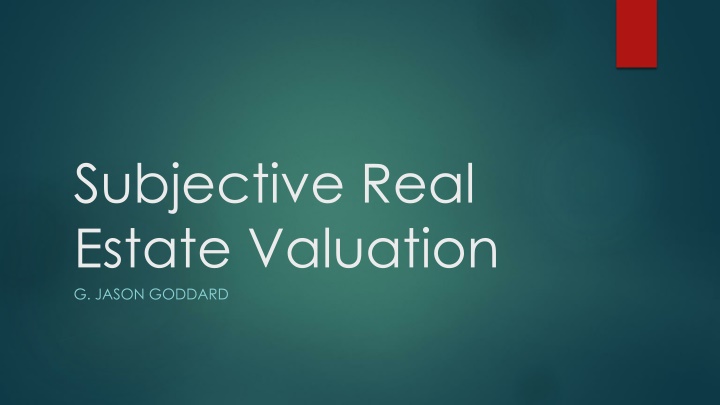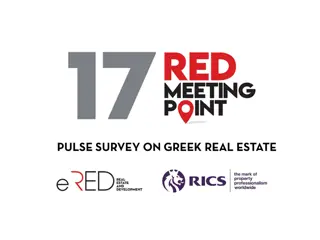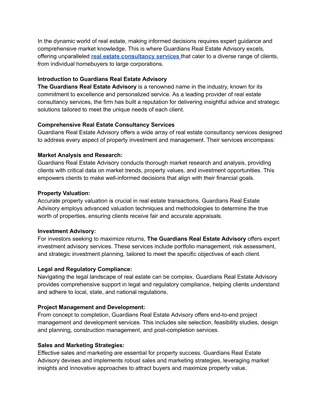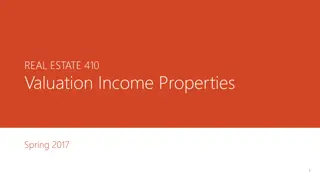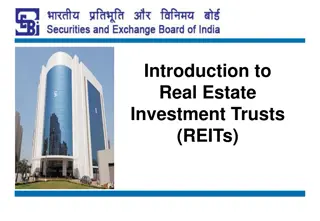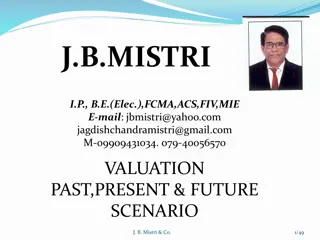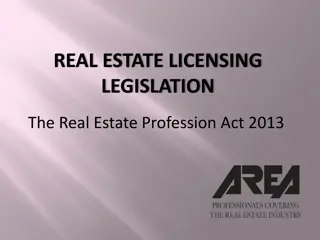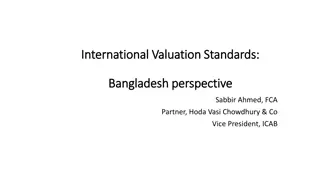Real Estate Valuation and Credit Analysis
Intricate world of subjective real estate valuation with insights into statistical modelling, variability scenarios, and the five Cs of credit analysis. Discover the importance of character, capacity, collateral, capital, and conditions in credit decision-making. Delve into AI and machine learning applications in property valuation.
Download Presentation

Please find below an Image/Link to download the presentation.
The content on the website is provided AS IS for your information and personal use only. It may not be sold, licensed, or shared on other websites without obtaining consent from the author.If you encounter any issues during the download, it is possible that the publisher has removed the file from their server.
You are allowed to download the files provided on this website for personal or commercial use, subject to the condition that they are used lawfully. All files are the property of their respective owners.
The content on the website is provided AS IS for your information and personal use only. It may not be sold, licensed, or shared on other websites without obtaining consent from the author.
E N D
Presentation Transcript
Subjective Real Estate Valuation G. JASON GODDARD
Chapter 2 Outline Chapter Highlights A Brief History of the Credit Decision Existing models for assuming away variability in valuation Artificial Intelligence in real estate property valuation Machine Learning in real estate property valuation Algorithm subjectivity
The Five Cs of Credit Character Capacity Collateral Capital Conditions Which of these are the most important and why?
Statistical Modelling and Variability Pessimistic Scenario Year Equity CF Resale Total IRR 0 1 2 3 4 5 (1,500,000) 150,000 147,000 144,060 141,179 138,355 1,400,000 1,538,355 (1,500,000) 150,000 147,000 144,060 141,179 8.51% Internal Rate of Return for Pessimistic Scenario
Statistical Modelling and Variability Most Likely Scenario Year Equity CF Resale Total IRR 0 1 2 3 4 5 (1,500,000) 150,000 150,000 150,000 150,000 150,000 1,600,000 1,750,000 (1,500,000) 150,000 150,000 150,000 150,000 11.07% Internal Rate of Return for Most Likely Scenario
Statistical Modelling and Variability Optimistic Scenario Year Equity CF Resale Total IRR 0 1 2 3 4 5 (1,500,000) 150,000 154,500 159,135 163,909 168,826 1,900,000 2,068,826 (1,500,000) 150,000 154,500 159,135 163,909 14.53% Internal Rate of Return for Optimistic Scenario
Statistical Modelling and Variability IRR x Prob 2.55% 4.43% 4.36% 11.34% Value x Prob 420,000 $ 640,000 $ 570,000 $ 1,630,000 $ IRR 8.51% 11.07% 14.53% Total Prob 30% 40% 30% 100% Value 1,400,000 $ 1,600,000 $ 1,900,000 $ Expected IRR and Property Value
Statistical Modelling and Variability Estimated Expected IRR 8.51 11.07 14.53 Squared Deviation 8.01 0.07 10.18 Probability Probability Product 30% 40% 30% Variance Std. Dev Return 11.34 11.34 11.34 Deviation -2.83 -0.27 3.19 Pessimistic Most Likely Optimistic 2.40 0.03 3.05 5.48 2.34 Range of Expected Returns 9.00 11.34 13.68 Variance and Standard Deviation of Property Performance
Statistical Modelling and Variability Estimated Value 1,400,000 1,600,000 1,900,000 Expected Return 1,600,000 1,600,000 1,600,000 Squared Deviation 40,000,000,000 90,000,000,000 Probability Probability 30% 40% 30% Variance Std. Dev Deviation (200,000) 300,000 Product 12,000,000,000 27,000,000,000 39,000,000,000 Pessimistic Most Likely Optimistic - - - Range of Expected Values 197,484 1,402,516 1,600,000 1,797,484 Variance and Standard Deviation of Property Value
Income Approach and Variability Rent psf $ $ $ $ $ Sq Ft 5,000 4,500 5,000 4,500 19,000 Annual $ $ $ $ $ $ $ 10.00 10.50 10.00 11.75 10.53 Tenant 1 Tenant 2 Tenant 3 Tenant 4 Total GPI Vacancy Effective Gross Income 50,000 47,250 50,000 52,875 200,125 20,013 180,113 10.00% Operating Expenses: Taxes Insurance Repairs & Maintenance Utilities Management Other Replacement Reserves Total Operating Expenses Net Operating Income Cap Rate Estimated Value 25,000 8,900 12,000 15,000 9,006 5,000 4,503 79,408 100,704 8.50% 1,180,000 $ $ $ $ $ $ $ $ $ 5.00% 2.50% Direct Capitalization Model
Income Approach and Variability Valuation Subjectivity Vacancy % Cap Rate 10.00% 10.00% 5.00% 5.00% 10.00% 0.00% Value 1,180,000 $ 1,260,000 $ 1,290,000 $ 1,220,000 $ 1,120,000 $ 1,400,000 $ % 8.50% 8.00% 8.50% 9.00% 9.00% 8.50% 0.00% -6.35% -8.53% -3.28% 5.36% -15.71% Direct Cap and Valuation Subjectivity
Income Approach and Variability Period GPI Vacancy EGI Op Ex TI LC NOI ADS Reversion Equity CF 0 1 2 3 4 5 6 200,125 $ $ 200,125 70,044 130,081 64,479 $ $ $ 206,129 103,064 103,064 72,145 35,275 23,189 (27,545) 64,479 $ $ $ 212,313 55,872 156,441 74,309 19,123 12,571 50,438 64,479 $ $ $ 218,682 51,793 166,889 76,539 17,727 11,653 60,970 64,479 $ $ 225,242 78,835 $ 146,408 64,479 225,242 232,000 $ 23,200 208,800 $ 81,200 $ - - - - - - 127,600 1,563,098 $ $ (550,000) 65,602 (92,024) (14,041) (3,509) 1,008,280 Property Value 1,290,000.00 $ Discounted Cash Flow Valuation Model
Income Approach and Variability Rollover Risk over Holding Period Year 1 Year 2 50% Year 3 26% Year 4 24% Year 5 Holding Period Assumptions 0% GPI Growth Op Ex Growth Op Ex % of EGI TI Cost New TI Cost Renew LC Cost New LC Cost Renew Avg. Lease Term (yrs) 3.00% 3.00% 35.00% 5.00 2.00 6.00% 2.00% $ $ 0% Lease Rollover Risk 5 Loan Terms Reversion Assumptions Interest Rate Loan Amount Amortization (yrs) Selling Price 6.00% 750,000 Terminal Cap Reversion Sales Costs OB Balance Equity CF5 Selling Cost 8% 1,594,998 31,900 636,747 926,351 2.00% $ $ $ $ $ 20 1,300,000 $ DCF Assumptions Reversion Assumptions
Real Estate Technology Grounding Artificial Intelligence: Theory and development of computer systems able to perform tasks that normally require human intelligence. Machine learning: Use and development of computer systems that are able to learn and adapt without following explicit instructions, by using algorithms and statistical models to analyze and draw inferences from patterns in data.
Putting it all Together Flow Chart for Fully-Automated Commercial Real Estate Valuation Model
Chapter 2 Questions Questions for Discussion Which of the Five C s are most important, and which might be the most difficult for an algorithm to provide meaningful prediction? How can statistics be utilized to reduce the importance of the range of property values by instead focusing on a range of investor returns? What are other means of utilizing statistics which can indirectly result in a lack of emphasis on the presence of a range of property values? Describe situations where statistics can be utilized to reinforce the subjectivity of value. Describe the subjectivity of value as it relates to the direct capitalization model. Outline areas in the model where numerous solutions can most prominently impact value.
Chapter 2 Questions Questions for Discussion Describe the subjectivity of value as it relates to the discounted cash flow model. Outline areas in the model where numerous solutions can most prominently impact value. Describe current and possible future advances in artificial intelligence in real estate. Describe current and possible future advances in machine learning in real estate. Explain the challenges of making algorithms subjective. Should there be an element of subjectivity in algorithms? Describe the pros and cons of this issue and take a position and defend.
Chapter 2 Market Vignette Questions for Discussion Discuss how the subjectivity of value is apparent in this case. Discuss the strengths and weaknesses of the portfolio management tool initially created by this Fin-Tech. Outline the strengths and weaknesses of the plans for a fully- automated commercial real estate valuation model. What objections might the financial institutions have for this new product offering? What objections might the regulators have for this new product offering?
